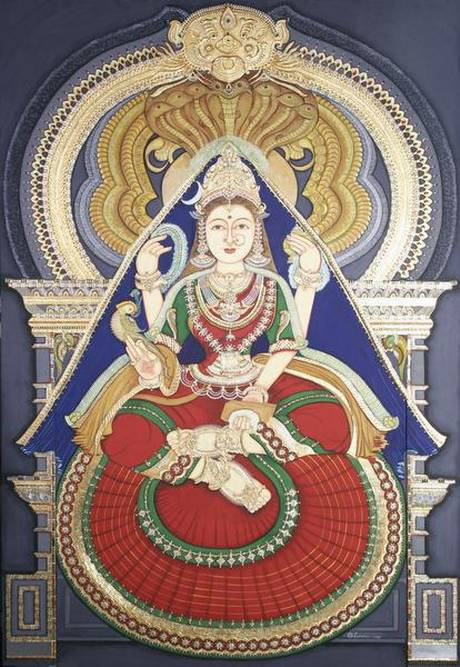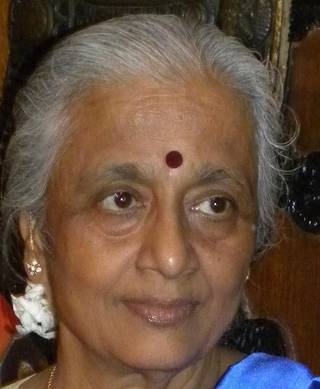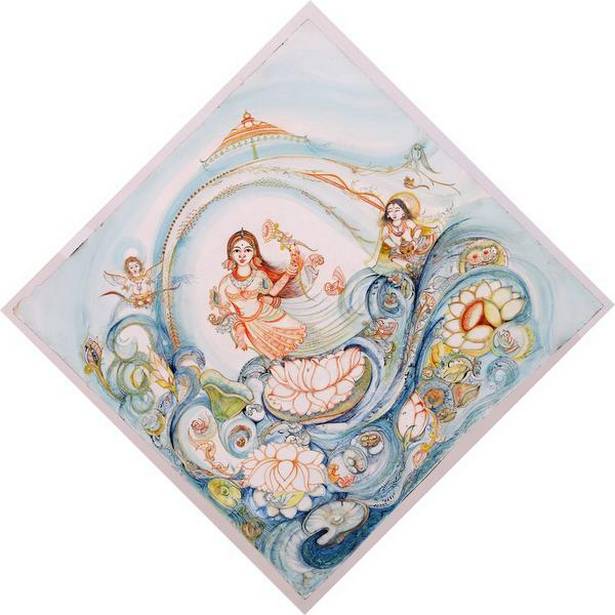Lakshmi Krishnamurthy tells us how Kalakshetra’s Visual Arts Department is coming out of the shadows

For decades since its establishment in 1936, Kalakshetra in Chennai has been known as a premier institution for Bharatanatyam and applauded for its dance drama productions. The music department has been a close second. But the visual arts section, despite being a vibrant training ground led by eminent artists and an inexhaustible support for the institution’s stage craft requirements, never got the same exposure as the performing arts.
Things are changing though. This February, the institution’s visual arts students, staff and alumni put up an exhibition in Chennai’s Lalit Kala Akademi — “Kalanubhava”, featuring paintings and sculptures. Organised by the Kalakshetra Alumni Association along with Kalakshetra Foundation, this exhibition was, somewhat shockingly, the first ever such event to take place since the department started in 1942.
In early March, when the Kalakshetra Alumni Reunion was organised in North India to coincide with Rukmini Devi’s birth anniversary celebrations, the visual arts alumni once again exhibited. The event that travelled from New Delhi to Chandigarh and Kalka included illustrated talks by Lakshmi Krishnamurthy, currently heading Kalakshetra’s Visual Arts department.

Lakshmi was honoured on a platform shared with Gurus N.S. Jayalakshmi, Shanta and V.P. Dhanajayan, C.V. Chandrasekhar, and C.K. Balagopal. “I was humbled to represent Visual Arts along with stalwart dance gurus,” says Lakshmi. The camaraderie, the presence of chief guest Yamini Krishnamurti and the praise showered on the exhibition by reunion organisers Swagata Sen Pillai and senior dancer Jayalakshmi Eshwar, she says, “brought tears to my eyes.”
She notes it was Kalakshetra’s current director Revathi Ramachandran who first addressed the visual and performing arts faculty on an equal footing and broached the idea of including an exhibition in Kalakshetra’s famous Art Festival, which for the past eight decades has featured only dance and music performances. These deliberations and alumni interest set the ball rolling.
The exhibitions paid homage not only to the aesthetics of Rukmini Devi (the topic of one of Lakshmi’s presentations) but also to the department’s first head, the late K. Sreenivasulu (1923-1995). A Fellow of the national Lalit Kala Akademi, Sreenivasulu is remembered alongside Jamini Roy for his love of rural art traditions and the ability to blend ancient techniques with modern sensibilities.
Lakshmi says, “Kalakshetra was/is synonymous only with dance. Now it is the genesis of the Visual Arts Department.”
Importantly, Kalakshetra’s dance students were never led to believe their art could flourish without the allies of music and visual arts. An important aspect of their training was a perspective on the interconnectedness of the arts and their relation to everyday life. The students learnt about the importance of raga choices, colours and fabrics, sculpture traditions and the intricate craft of coconut frond decorations; shared the campus with the Kalamkari unit and the dairy, and saw the moods of the sea close-up. Their routine included drawing and painting classes under Sreenivasulu, as well as informal training as his assistants during the preparation of props and sets.
Lakshmi and her colleagues too have designed sets and headgear and helped in restoration. The symbiotic relationship between performers and visual artists was underlined by Lakshmi at the Delhi alumni meet where she told the gathering, largely comprising dancers, “Your aharya (costuming and set design) needs us!”
Rukmini Devi’s first performance of Bharatanatyam in the 1930s highlighted this “confluence of visual and performing arts,” remarks Lakshmi. “She used a temple in the backdrop, and the front curtain had Nandi – The vahana of Shiva Nataraja.”
Experiencing the aesthetics of a performance in Kalakshetra, she feels, “spoils” viewers who then cannot settle for less. “The stage is set in a semicircular format, with puja area one step down on the right of the stage and the accompanists’ area on the left, also one step down. Lighting leads you to the puja area where the lamp devoid of the stem is aglow with five wicks and placed on a floral plate, thus avoiding visual disturbance. Focus is generated from accompanists’ area to the puja to the performer. The triangle is effective and alluring, the (spectators’) eyes dance with the dancers. The symphony is so phenomenal that the performance reaches a crescendo. From the entrance, the simple thorans, kolam and other decorations declare that minimal is beautiful.”

Symbiosis aside, dancers trained at Kalakshetra tend to carry a stamp — adhering to a recognised ‘gharana’ or bani of Bharatanatyam — while the visual artists display no such gharana allegiance. Perhaps, this came about because under Sreenivasulu, the training was individualised.
“With sir, it was one-to-one,” says Lakshmi, who enrolled in 1986. “He could turn a moth into a butterfly.” She did follow a syllabus, but when she asked for old techniques, “the floodgates opened.” She learnt various mural traditions, Thanjavur painting, glass painting and folk styles among others, bolstered by her penchant for academic research.
“When you are learning a new technique, copying is allowed — but not tracing — to focus on the nuances of the technique,” says the noted artist. But once the technique is acquired, “a little of one’s self should be there. It should come from within.”
Appointed as HOD in 2011, Lakshmi consolidated the syllabus as a tribute to her predecessor and guru. While artist Palaniappan helped her organise the other areas of study, explains Lakshmi, the Indian art component was completely designed by her. Topics include the shadangas (the six essential aspects of painting, including appearance, emotion, precision, etc.), human figure proportion based on the Shilpa shastras, miniature paintings, besides different mediums including glass and jewellery design, art direction and creative composition in pan-Indian techniques. In the fourth year, students choose a specialisation.
After the course, “they can pursue post-graduation in Madras University and post graduate diploma course in Santiniketan,” says Lakshmi, adding, “We are trying to open up to more universities.”
Pointing out that Kalakshetra is “the only college giving such a detailed Indian art programme,” Lakshmi states that students can enter teaching, art direction, advertising, logo designing, digital arts, and more.
Lakshmi submitted a proposal in 2013 to paint murals on the cottages along the path to the auditorium, featuring scenes from Rukmini Devi’s iconic Ramayana series of dramas, using various Indian painting traditions. “The idea was to invite artists, and students could help and learn at the same time.” She has discussed the scenes from each drama with Guru A. Janardhanan, among the handful of veteran dancers remaining, on whom Rukmini Devi choreographed the productions over 14 years starting 1955.
The purpose of the Kalakshetra Foundation Act of 1993, under which the Government declared Kalakshetra an institution of national importance, was to further the objectives for which Rukmini Devi founded it. With some artists who worked with Rukmini Devi still in the field, the time is more than ripe to build on the enthusiasm engendered by recent events and implement the mural painting proposal among others. Such projects, provided they are well thought through, would help clarify the significance of this institution to the current generation.
source: http://www.thehindu.com / The Hindu / Home> Entertainment> Art / by Anjana Rajan / March 29th, 2019